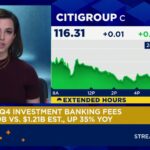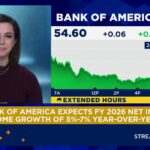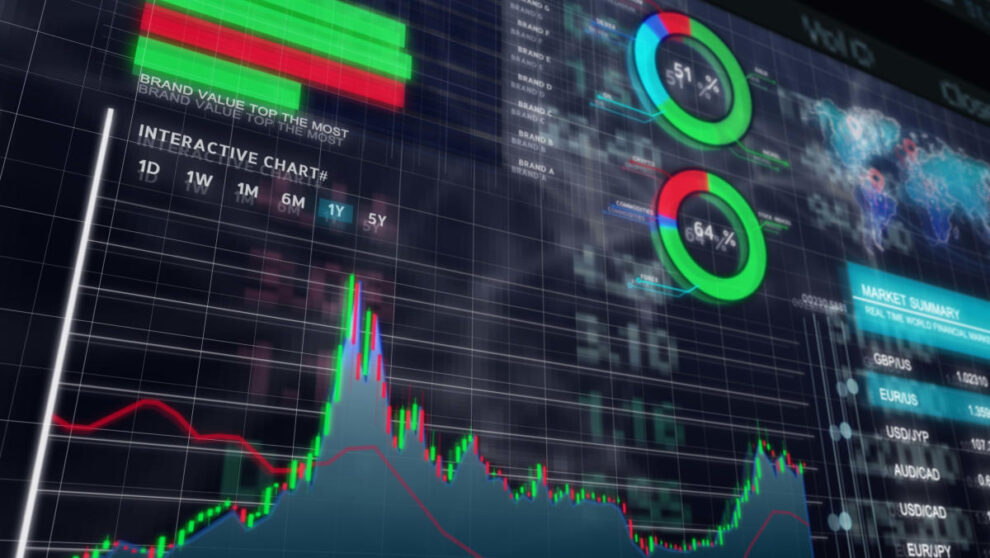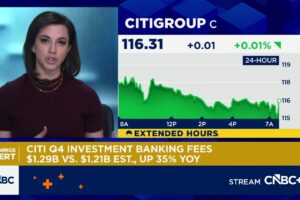On today’s episode of Asking for a Trend, host Josh Lipton delves into recession concerns, market takeaways, box office slowdowns, and more.
Yahoo Finance’s Julie Hyman provides insight into the yield market and what it may signal for potential recession risks.
Yahoo Finance’s Josh Schafer breaks down the top three market takeaways from Tuesday’s trading session, including Nvidia’s (NVDA) record-breaking close.
Macquarie Senior Analyst Chad Beynon also joins the show to discuss the slowdown in the US box office and its implications for movie theaters.
This post was written by Angel Smith
Video Transcript
Hello and welcome to Yahoo Finances.
Asking for a trend.
I’m Josh Lipton for the next half hour.
We’re gonna be breaking down the trends today that will move stocks tomorrow.
There’s a lot to keep track of.
So we’re focusing on what you need to know to get ahead of that curve.
Here are some of the trends we’re gonna be diving into consumer confidence is on the rise but inflation concerns linger.
We got an exclusive look at consumer credit to determine how it’s showing up in spending and Memorial Day travel hit record highs this weekend.
But movie goers failed to bring the heat to the box office more on what the lackluster ticket sales means for theaters this summer and beyond.
Plus one of Wall Street’s favorite recession indicators could break its winning streak here.
We’re taking a look at the off site inverted yield curve in our chart of the day.
Consumers aren’t just feeling better.
They’ve got the credit to back it up.
Vantage score saw the average Americans credit score improve from a month ago following a trend of declining delinquencies.
Yahoo finance has an exclusive first look at vantage score’s latest data.
On consumer credit CEO and President Silvio Tavares joins us now with a close look at the trends he’s seeing Silvio.
It is good to see you.
So and it’s a perfect time to have you Silvio because we know, listen, we we’re through earning season.
Basically, we had a lot of different data points on the consumer and investors are trying to get a hold of Silvio.
How healthy and resilient is the consumer right now.
What are you seeing, Silvio in the credit, credit data you have?
Well, uh the good news is the consumer is actually very healthy and actually improving in overall credit health.
Josh, thank you for having me on.
And as you look at through the end of April, the average vantage score was 702. the lowest vantage score is 350 the highest is 8 57 02 is a great credit score and that’s where we’re seeing the average consumer uh come in and it’s not just that it’s not just the consumer is actually increasingly credit, healthy banks are actually increasing their lending.
And so we saw originations of new credit accounts, credit cards, um auto loans, et cetera.
We saw all of those actually increasing through the end of April, all good news and makes it unlikely the fed is going to cut any time soon.
I wanna get back to it because what it sounds like you’re saying, correct me wrong is generally things look pretty good, but there’s some bifurcation here.
And so I’m, I’m just interested, get some puts and takes there.
Like what is, what is Sylvia elevating some folks higher into the sort of super prime but pushing others out of that prime tier?
Well, like in all things, um the average is sometimes mask uh two different realities.
Um and that’s certainly what we’re seeing in the latest insights from our monthly vanish for credit gauge overall, as I mentioned, the consumer credit healthy and we’ve been actually very bullish on the consumer for the most part of last year as others were uh forecasting.
Um the untimely death of consumer spending that didn’t happen in the day just shows us that so overall, very uh healthy average consumer, but there are segments showing some weakness and certainly we’re seeing younger, less affluent consumers under stress, those consumers tend to disproportionately use credit cards.
And for most of the other credit, credit products, we did not see an increase in delinquencies and certainly not uh uh compared to pre pandemic levels.
But credit card was an exception there.
We’re seeing consumers seeing increased delinquency rates and delinquency rates are actually higher than pre pandemic.
And so those lower, less affluent, lower income, less affluent consumers are struggling.
And um uh we, we, we see that um in the numbers and so you, you mentioned the banks, I want to swing back on that because what are the banks seeing right now, what do they make of this environment, Sylvio and how are they competing for customers?
Well, this is the big challenge right now because the Federal Reserve wants banks to be tightening credit ma making less loans.
And um, we’re not seeing that.
In fact, we’re seeing the opposite of that.
Uh, banks are actually increasing their lending.
And the simple reason is consumers have high average credit scores.
Consumers are employed for the most part.
And as you would expect banks to do banks are me Sylvia, I think we had some audio issues there, but we thank you for that time.
And an important data tech heavy NASDAQ reaching record highs as the benchmark S and P 500 finishes the day just above the flat line.
Here was some of the trading day takeaways as Yahoo Finance’s Josh Schafer Josh.
Hey Josh.
Yeah.
So we’re gonna start with that trading action for today.
Our top takeaway today which just moves in the 10 year treasury yield still remaining noteworthy and perhaps a headwind for stocks when we see the 10 year treasury yield come up.
So I want to take a look closer at some of the charts here specifically with the S and P 500.
You look at the S and P today when we really started heading lower was right around 1 p.m. right?
That’s where we took that leg lower.
Well, if we look at the bond market, Josh and we look at what happened at that time.
Let’s look at the tenure.
That’s right.
When the 10 year started peaking up.
Right.
And this is a trend we’ve been talking about for a while.
Now when I zoom out here and we look at the 10 year over the last two months, if I can get that to work, it’s not gonna work for me.
But over the last two months, you can see when the tenure goes up.
Realistically, what’s been happening is stocks have been down right.
Here’s what I was looking for.
So this is when the tenure went up a lot, right?
We were talking about it pretty much daily on the show.
What happened in April, we had a 5% pull back in stocks right in the S and P 500.
So realistically just kind of the key trend to watch here has simply been when yields go up, it’s a headwind for stocks and on a day like today where it felt like NVIDIA is up positive vibes in the market, maybe a little bit of an A I rally.
Why didn’t you see more out of the S and P 500?
Sometimes your answer is right here and some of those bond offerings that happened at 1 p.m. and and and Josh also like, listen, basically earnings effectively in the rearview mirror.
So now you get back to Macro and you start focusing more on the benchmark tenure when you’re kind of combing through the notes.
What are some of the levels, you know, analysts, strategists, technicians, what are you looking at?
I, I think as we get between 4.5% and 5% on the tenure, it seems to be, be anything higher is not great.
There aren’t a ton of technical levels.
I’ve seen highlighted recently, like at one point we were looking 4.35 that five, we’re now past 4.5.
So it’s sort of where are we going to float in between there?
But I think what you pointed out there is key just moving forward, especially this week when we have PC at the end of the week, any moves that we’re seeing in the bond market with earnings, sort of in the rearview mirror, I think are gonna be probably a big driver for the market.
All right, what’s up next on the schafer T up next?
Let’s get back to earnings though, right?
Because earnings are exciting to talk about, right?
And another bullish call for the S and P 500.
This one coming from U BS UB Jonathan Golub, Jonathan go so much TV.
Jonathan.
I want to get him back, we gotta get him back, we gotta get him back to talk about charts like this because he’s talking a lot about earnings and really what stands out here.
So this is consensus expectations for earnings growth are these three numbers at the end So we’re looking for 17.6% earnings growth year over year in the fourth quarter.
That number has been moving up.
So is this number and so is this number, so this number 11.4% on the year that’s been steadily moving up over the last two months.
So has this number for 2025 at 14.2%.
And what gala points out normally those move down.
So go back here and you take a look at 11.4%.
Normally this number would be coming down and it would look more like this blue line here.
But what’s happening right now is analysts feel better about the outlook and if we’re feeling better about the earnings outlook, that is a good thing for stocks.
So to see it, this resilient up here is something that multiple strategists have been highlighting, say, ok, the earnings outlook is better than we thought that’s net net, just a positive for stocks and a positive for the R. So companies are better than maybe they initially thought if you looked under the hood, not necessarily what gollop seen, but just in general, Josh, where do you see sort of that positive earnings revision?
Yes.
So going back to the start of April, it’s been utilities and energy utility, energy have had the best earnings revisions of any of the sectors in the S and P 500.
Of course, if I were to pull up a chart of sectors over the last two months, utilities and energy have been rallying pretty good here.
So you’ve certainly seen that playing out in the market thus far.
The third one, we got one more take away.
You have to end.
We, we cannot talk about that all time high.
Today, closed over 1100 for the first time.
And I think what stuck out to me, I saw this chart from Goldman Sachs Josh.
And what we’re looking at here is data center, wallet share.
So sort of where the spending is going in data center.
You can see NVIDIA is in purple.
Look at that, I don’t need to say much chart.
You can just see the purple slowly take over.
And what this means to me is when someone like Elon Musk says that they’re building A I and they’re gonna need some way to power it.
It’s these guys in purple, right?
It’s all on video and nvidia benefits from that stock was up, I think about 5% today.
So it’s been interesting to just see how they’re sort of dominating this market, right?
You know, Elon Musk comes out Josh and he says my start up Xa I, we’re gonna be a player.
We’re gonna take on open A I, I’m gonna take on meta, I’m gonna raise $6 billion investors just think.
Well, then you’re gonna need Jensen Wong Jensen Wong talking about that 6 billion Elon Musk and A I financed last week.
It all starts to add together a little bit though.
Joshua.
Thank you.
Appreciate it.
Memorial Day.
Weekend’s box office was a flop.
But is our movie goers gonna blame or is Hollywood’s fault discussed on the other side?
More?
Asking for a trend coming right up.
Us, movie theaters had anything but a relaxing holiday weekend with the box office seeing its worst Memorial Day weekend performance since 1995 and a 37% drop just from 2023.
Joining us now to discuss the outlook for theaters is Chad Bynon mcquary, senior analyst, gaming, lodging and leisure chad.
It is good to see you.
So uh it sounds like the summer box office chad not off to a great start here.
What explains it now, thanks for having me, Josh.
Um As you just illustrated, it was a tough weekend.
Look, generally this is kind of the start of the summer you see about 20 million people who go out over the three or four day uh period in, in this year, we saw, you know, somewhere between 10 and 12 million.
So then the questions are, is it the consumer, is it the overall experience or was it a lack of content uh given the strikes that we had and kind of the delay of the backlog.
Um There were two big wide releases and the scores that we’ve seen particularly on Furioso were pretty strong in terms of um you know, just the reception of the movie.
So we are scratching our heads.
We’re searching for another Bar um, uh Barben Heimer.
Uh but we’re gonna have to wait until later this year to kind of kick start the industry.
You mentioned Chad, I mean, you know, last summer, like Barbie Oppenheimer, it was just this cultural phenomenon.
Is there anything like that chad coming down the pipeline?
Not to that degree?
I think the slate does look strong um in the back half of the year and in particular, in 25 actually, over the past week we saw more movies that were announced to be delivered in 25.
Um So there’s nothing that’s kind of a huge following, you know, as a reminder, sometimes it’s the, it’s the original content that kind of come out of left field and do 234 $500 million domestically, um wicked.
You know, there’s a few surprises that we like in the fourth quarter.
I could go through the list but a lot of Sequels and then you have a couple of original uh films uh particularly in Q four.
I’m just curious, you know, I know you don’t cover the names, but even just generally speaking, Chad does, uh does this kind of performance, does it put that much more pressure on Disney’s and universals in terms of what they have coming?
Absolutely.
You know, the past couple of years we’ve been excited to see more diversification from the studios, right?
Some of the independent films, The Apples, the Amazons, the A 20 fours elevating their presence and contributing more because I think pre COVID um Disney Studio accounted for almost 40% of admission revenues in North America.
We will, I want some more diversification here.
So, yes, absolutely.
We think there’s a lot of pressure on Disney’s um uh production, making sure that lands well with that younger audience and we just haven’t seen that over the last couple of years.
Um in terms of number of films, pre panem, we were around 130 across all the studios from a widely released standpoint, we’re inching up to 100.
So in 25 hopefully we get closer to that 130.
But I do think some of the, you know, the lines in the space uh need to put out some, some high quality content.
I’m interested chad when you just think about kind of overall box office as an industry.
How much smaller is it chad now than pre pre pandemic?
And how do you see kind of evolving from here?
Yeah, we’re, we’re right around 25% lower than pre pandemic.
And that’s on admission revenues.
And remember, pickup prices has have continued to go higher with inflation over the past couple of years.
So admissions are actually down more than 30%.
Um Admission revenue is prepa we’re in that $11 billion range this year, we’re going to be a little shy of 9 billion.
And then in 2025 we’re expecting something closer to 10 billion.
Um The industry has shrunk companies like a MC have reduced their screen size by about 10%.
So they’ve taken out a lot of the lower performing screens across the country.
The big winner, relative winner is IMAX this weekend.
For instance, they did 20% of furioso admission revenues and they have about 2% of the screens uh in the United States.
So clearly the consumers who are going to the movies are choosing the premium experience.
So you would say chad just for viewers, for investors who are lets right out.
IMAX is a, is a, is a buy here.
We like IMAX, IMAX, we have a $24 stock price.
They generate about a third of their um profits in North America, a third in China and then a third in the rest of the world.
So they’re diversified.
The second reason is they have a backlog uh similar to what we see with the hotel companies.
IMAC should grow their units anywhere between eight and 10% per year for the next three years.
And those are orders that just need to be fulfilled and they’re also a ticket taker.
They don’t run the um exhibition arena.
They just take a fee on uh the the number of uh admission revenues that come in the door.
So it should be a hire multiple company.
Um you know, in the early teens, this is a company that was trading 2015 to 20 times each.
Right now.
We have a trading at 7.5 times.
I uh so I don’t think it will get back to that franchise multiple like a hotel stock or some of the uh fast, fast casual chains.
But I think it’s a value stock with good growth.
It’s just been masked by everything that we’re talking about today with a general uh lower backdrop.
Chad, you were the perfect guy to talk about this story today.
Thanks so much for coming on the show.
I appreciate it.
Thanks, Josh.
Coming up, Wall Street’s favored recession indicator is not indicating like it used to more asking for a trend.
It’s on the other side, Wall Street may have a problem.
One of its favorite recession indicators has been flashing warning signals for more than a year, but we haven’t seen one yet.
So is the indicator broken or are we in store for a slow down?
Julie Hyman joins us now for a closer look, Julie.
Yeah, this is something that the Wall Street Journal highlighted today that it has been something like 400 trading sessions that the yield curve has been inverted.
That’s the difference in this case here between the 10 year yield and the two year yield.
And every time we have seen it invert.
In other words, the 10 year go below the two year, we have seen a recession.
This goes back all the way to the eighties.
We have inversion here that is going below zero here and there was a recession going inverted here.
Recession, inversion here, recession, inversion here, recession.
It even had inverted before the pandemic induced recession.
So now we have the inversion that is going on uh 2324 months, which is exceptionally long in the tooth to last before we see a recession.
Now to back up for just a second here.
What even is a yield curve here?
We’re talking about the difference between long term and short term bonds, the yield on long term and short term bonds.
And it looks at the relationship between the rates of interest.
We tend to see this inversion when the market anticipates a rate cut coming from the Federal Reserve.
And that’s why we see those long term yields slip below the short term yields so very long here.
And, you know, sort of adds up with all the other confounding economic data that we’ve gotten recently, Josh.
So we have a why here, Julie, what explains this conundrum.
So it effectively seems to be that people got it wrong, what the economy was going to do and what the Federal Reserve was going to do.
Recall in 2023 it was very difficult to find an economist or a market strategist that predicted that the economy would continue to expand.
And that stocks would continue to expand.
So there’s a lot of pessimism, they got sort of baked into this inversion as we know, this is sort of the federal reserve rate cut that has not arrived.
And so the longer that goes on and this inversion goes on, you know, the longer it just says that people were wrong about their predictions effectively, even the guy who sort of popularized this thing is quoted in the journal Campbell Harvey who’s now finance professor Duke said he can’t rely on a single measure to be sort of this magic predictor of recessions, even though its track record has been very good in the past.
And combine that Josh, as I said with, you know, we got a lot of other confusing indicators out there right now.
You know, you had a consumer confidence reading today that came in with a rebound for the month of May, but that’s not necessarily reflected in other figures.
So, um in other words, it’s really hard to be an economist right now and try to predict and to be a market participant, trying to figure out uh if and when a recession is coming, it is indeed Julie Hyman.
Thank you, appreciate it.
Time.
Now for what two watch Wednesday, May 29th.
Before the opening bell, investors can expect to hear from several retailers, Abercrombie and Fitch American Eagles, exporting goods and Chewy all set to deliver first quarter results and get more insight of course, into consumer spending.
This company as consumer confidence saw him move higher in May after three straight declines.
Then after the market closed, we’re going to look into tech with names such as sales force C three A I and HP INC also point their latest financial results investors to ice spending in cloud and business software offerings from sales force customers while keeping watch on commentary from HP on recovering that PC market and turning to the fed New York fed President John Williams and Atlanta fed President Rafael Bostic slave to deliver remarks on Wednesday.
Meanwhile, the central bank is set to release the Federal Reserve’s beige book with the latest on current economic conditions.
That’s a wrap on today’s asking for a trend.
Be sure to come back tomorrow at 4:30 p.m. Eastern for all of the latest market, moving stories affecting your wallet.
Have a great night.











